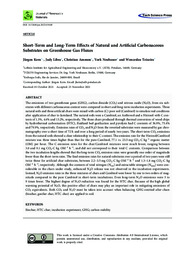Short-term and long-term effects of natural and artificial carbonaceous substrates on greenhouse gas fluxes.
Short-term and long-term effects of natural and artificial carbonaceous substrates on greenhouse gas fluxes.
Author(s): KERN, J.; LIBRA, J.; AMMON, C.; NEUBAUER, Y.; TEIXEIRA, W. G.
Summary: The emissions of two greenhouse gases (GHG), carbon dioxide (CO2) and nitrous oxide (N2O), from six substrates with different carbonaceous content were compared in short and long-term incubation experiments. Three natural soils and three artificial chars were mixed with carbon (C) poor soil (Cambisol) to simulate real conditions after application of char to farmland. The natural soils were a Cambisol, an Anthrosol and a Histosol with C contents of 1.3%, 4.4% and 13.2%, respectively. The three chars produced through thermal conversion of wood chips by hydrothermal carbonisation (HTC), fluidized bed gasification and pyrolysis had C contents of 56.9%, 75.4% and 79.9%, respectively. Emission rates of CO2 and N2O from the rewetted substrates were measured by gas chromatography over a short time of 72 h and over a long period of nearly two years. The short-term CO2 emissions from the natural soils showed a clear relationship to their C content. The emission rate for the Histosol/Cambisol mixture was three times higher than that for the pure Cambisol, 77.1 vs. 23.5 mg CO2-C kg(-1) organic matter (OM) per hour. The C emission rates for the char/Cambisol mixtures were much lower, ranging between 3.0 and 9.1 mg CO2-C kg OM-1 h(-1), and did not correspond to their total C contents. Comparison between the two incubation lengths showed that the long-term CO2 emission rates were generally one order of magnitude lower than the short-term rates. The final emission rates for natural substrates over a period of two years were still twice those for artificial char substrates, between 2.2-3.5 mg CO2-C kg OM-1 h(-1), and 1.3-1.8 mg CO2-C kg OM-1 respectively. Although the contents of total nitrogen (N-tot) and extractable nitrogen (N-min) were con siderable in the chars under study, enhanced N2O release was not observed in the incubation experiments. Instead, N2O emission rates in the three mixtures of chars and Cambisol were lower by one to two orders of magnitude compared to the pure Cambisol in short-term incubations. Even long-term N(2)O( )emissions were 5 to 9 times lower. The highest degree of N2O reduction was found for the HTC char. Because of the high global warming potential of N2O, this positive effect of chars may play an important role in mitigating emissions of CO2 equivalents. Both CO2 and N2O must be taken into account when balancing GHG emitted after chars (biochar, gasifier char, HTC char) are applied to soil.
Publication year: 2022
Types of publication: Journal article
Unit: Embrapa Soils
Keywords: Biochar, Carbon, Carbon stability, GHG, Greenhouse gases, HTC char, Incubation experiment
Observation
Some of Embrapa's publications are published as ePub files. To read them, use or download one of the following free software options to your computer or mobile device. Android: Google Play Books; IOS: iBooks; Windows and Linux: Calibre.
Access other publications
Access the Agricultural Research Database (BDPA) to consult Embrapa's full library collection and records.
Visit Embrapa Bookstore to purchase books and other publications sold by Embrapa.

